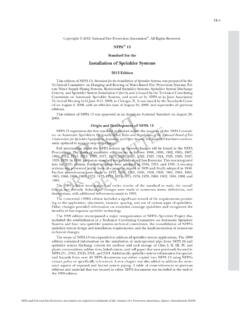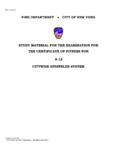Transcription of Sprinkler system types - Wiginton Fire Systems
1 Sprinkler system typesWet Wet type Systems are the most common type of Sprinkler system that is installed. A wet pipe system has water in the pipes in the ambient or normal condition and has heat responsive elements on all sprinklers. Thus, water is instantaneously discharged from a Sprinkler when it In areas where low temperatures could cause a wet pipe system to freeze, a dry pipe system is intended for use. Dry pipe Systems are pressurized with air in the ambient condition and experience an inherent delay in the discharge of water to allow the pressurized air in the system to escape. When a Sprinkler actuates, air is released through the Sprinkler , allowing water to flow into the piping system through the dry pipe valve. NFPA 13 mandates that the time for the water to reach the most remote Sprinkler be no longer than 60 seconds.
2 This time delay allows the fire to grow larger than it would with a wet pipe system of similar design, and the larger fire size results in more sprinklers in the fire area limit the size of dry pipe Systems , a volumetric limitation with a maximum capacity of 750 gallons is placed on dry pipe Systems . A quick opening device, such as an accelerator or an exhauster, is installed to rapidly remove air from the system and speed the operation of the dry pipe valve and is required when the system volumetric capacity exceeds 500 and Deluge Preaction Systems and deluge Systems required fire detectors (smoke, heat, etc.) for the actuation of the system . A deluge system uses open sprinklers or nozzles, so that all flow water is discharged when the deluge valve actuates.
3 Deluge Systems can be used for occupancies where the hazard is considered severe, such as with flammable liquid hazards where the fire could spread over a large floor system have closed heads and pipes filled with pressurized air that supervise a piping system , and can be considered for the protection of valuable assets or irreplaceable property. The detection system for a preaction system can be designed to prevent water discharge in cases of a false alarm from the detection system , or in case of a Sprinkler whose element has encountered mechanical detection system on a preaction system can be designed with a preaction logic capable of meeting one of the following objectives:-Actuation of a fire detector trips a deluge valve to admit water into the Sprinkler piping to await the actuation of a of a fire detector or actuation of a heat-responsive element on a Sprinkler trips a deluge valve to admit water into the Sprinkler of a fire detector and actuation of a heat-responsive element on a Sprinkler trips a deluge valve to admit water into the Sprinkler piping.
4 Sprinkler Head TypesSpray sprinklers are manufactured in three basic styles. A standard spray upright (SSU) Sprinkler is mounted on upright above a branch line pipe, usually in a room with exposed structural elements, and has a deflector, a metal plate whose edge is distinctively bent to deflect water downward from the Sprinkler . A standard spray pendant (SSP) Sprinkler is mounted below the branch line, usually mounted at or below the surface of a suspended ceiling and is characterized by a flat deflector. SSU and SSP discharge patterns are designed to be the same. Sidewall sprinklers have a specifically designed deflector that allows the Sprinkler to discharge water from a wall-mounted on upright, pendant, and sidewall Sprinkler are the dry upright, dry pendant, and dry sidewall sprinklers.
5 These special sprinklers are manufactured with a seal at the inlet that prevents water from entering the nipple until the Sprinkler actuates. These sprinklers can be extended from a wet pipe system into an unheated area, such as a walk-in freezer, an outside loading dock, or an unheated attic space, or can be used in the pendant position on a dry pipe system to prevent condensation from entering the Sprinkler and freezing. Pendant Head Upright Head Sidewall head Concealed Head Dry Pendant Head Sprinkler Head Temperature Ratings Max Ceiling Temperature (F) Head Temperature Rating (F) Temperature Classification Color Code Glass Bulb Color 100135-170 OrdinaryUncolored or Black Orange or Red 150175-225 IntermediateWhiteYellow or Green 225250-300 HighBlueBlue300325-375 Extra High RedPurple375400-475 Very Extra High GreenBlack475500-575 Ultra High OrangeBlack625650 Ultra High OrangeBlack Sprinkler CoverageAnother development in Sprinkler manufacturing is the extended coverage Sprinkler .
6 The deflectors on these sprinklers are designed to discharge water over larger areas than standard sprinklers. While this means that each Sprinkler must have a higher flow, it results in increased allowable distance between sprinklers, with the possibility that fewer sprinklers may be required in a compartment given ResponsesA major development in Sprinkler technology was the quick response Sprinkler , a Sprinkler with a specially designed response element that allows the rapid transfer of heat to the heat-responsive element and provides a more expeditious delivery of water to the fire. At the time of Sprinkler actuation, the fire should be smaller with a quick response Sprinkler than with a standard response Sprinkler , resulting in fewer sprinklers likely to actuate.
7 Sprinkler elements are either glass bulbs or eutectic (soldered) elements. The response of quick response and standard response sprinklers can be modeled by designers to estimate the time for a Sprinkler to actuate, given ceiling height, fire size, and response time index (RTI), using the DETACT computer program, developed by the Building and Fire Research Laboratory at the National Institute of Standards and Technology (NIST). Response time index is a measure of the sensitivity of a Sprinkler heat responsive element, with low RTI values being very sensitive to actuation by heat, and high RTI values being less for Storage ApplicationsESFR and large Drop sprinklers are for specialized high challenge fire hazards. An ESFR Sprinkler has a quick response element and an extra large orifice that allows for greater amounts of water to be applied early in the fire development, usually on a high challenge fire.
8 Large drop sprinklers have large deflectors with widely spaced teeth to facilitate the creation of large water drops intended to penetrate a high velocity fire plume without evaporating, resulting in some water reaching the burning materials. The fire plume is the column of smoke and gas traveling upward from a system Inspection RequirementsNFPA requires that certain activities be performed at prescribed frequencies. However, rarely does an inspection and test agreement assign all of these activities and frequencies to a fire prevention company. To comply fully, an implied partnership is formed between the owner or the owner s representative and the contractor. All of the requirements of NFPA 25 are the responsibility of the owner, and the contractor relies on the owner to perform all inspections and tests not specified in the common agreement for a wet Sprinkler system will have the fire protection contractor coming to the building on an annual basis to conduct the annual inspections (See Below), while the owner or owner s representative performs the quarterly, monthly, and weekly required specifically referenced in the agreement all other less-frequent activities are not included such as testing gauges every 5 years, testing sprinklers every 5, 10, 20, or 50 years; and internally inspecting alarm valve, check valves, strainers, filters, and orifices.
9 These activities are normally performed by the fire protection contractor but are invoiced as additional periodic system Inspection Frequencies DeviceActivityFrequencySprinkler system Gauges (Dry, Pre-Action, Deluge Systems ) InspectionWeekly/MonthlyControl Valves InspectionWeekly/MonthlyAlarm Devices InspectionQuarterlyGauges (Wet Pipe Systems ) InspectionMonthlyHydraulic Nameplate InspectionQuarterlyBuildingsInspectionAn nually (prior to freezing) Hanger/Seismic Bracing InspectionAnnuallyPipe and Fittings InspectionAnnuallySprinklersInspectionAn nuallySpare Sprinklers InspectionAnnuallyFire Department Connections InspectionQuarterlyAlarm Devices TestQuarterly/Semi-AnnuallyMain Drain TestAnnuallyAnti-freeze Solution TestAnnuallyGaugesTest5 years Sprinklers -- Extra High Temperature Test5 years Sprinklers -- Fast Response TestAt 20 years and every 10 thereafter SprinklersTestAt 50 years and every 10 thereafter ValvesMaintenanceAnnually or as needed ObstructionMaintenance5 years or as needed Low Point Drains (Dry Pipe Systems ) MaintenanceAnnually prior to freezing and as needed Private Fire Service Main Hose Houses InspectionQuarterlyHydrants (Dry Barrel with Wall)
10 InspectionAnnually and after each operation Monitor Nozzle InspectionSemi-AnnuallyHydrants (Wet Barrel) InspectionAnnually and after each operation Mainline Strainers InspectionAnnually and after each significant flow Piping (Exposed) InspectionAnnuallyPiping (Underground) InspectionSee NFPA 25 Monitor Nozzle TestFlow Annually (Range and Operation) HydrantsTestFlow Annually Piping (Exposed and Underground) Flow Test 5 years Mainline Strainers MaintenanceAnnually and after each operation Hose Houses MaintenanceAnnuallyHydrantsMaintenanceAn nuallyMonitor Nozzle MaintenanceAnnuallyStandpipeControl Valves InspectionWeekly/MonthlyPressure Regulating Devices InspectionQuarterlyPipingInspectionQuart erlyHose Connections InspectionQuarterlyCabinetInspectionAnnu allyHoseInspectionAnnuallyHose Storage Device InspectionAnnuallyAlarm Device TestQuarterlyHose Nozzle TestAnnuallyHose Storage Device TestAnnuallyHoseTest5 years/3 years Pressure Control Valve Test5 years Pressure Reducing Valve Test5 years Hydrostatic Test Test5 years Flow Test Test5 years Main Drain Test TestAnnuallyHose Connections MaintenanceAnnuallyValvesMaintenanceAnnu ally or as needed Water






